The kettlebell is a very powerful tool for building strength and developing conditioning. The principles and techniques taught by Pavel and StrongFirst are the gold standard when it comes to kettlebell training. Whether you’re training to prepare for an SFG Instructor weekend or just for general health, the principles laid out by StrongFirst apply to you. One of these principles is safety. In the SFG I manual there is a Rob Lawrence quote that states, “Safety is viewed as a part of, not the opposite of, performance.” Safe training is of the highest priority.
Now to me the StrongFirst community is Strong, Honourable, and Uncompromising. So it seems odd to even think about something as trivial as Hand Care. However, ripped, torn, and bloody hands are not a badge of honour and in fact can be a sign of either poor technique, a weak grip, or a disregard for the safe training principle. Although this article is primarily written for those preparing for an SFG event, the topic applies to anyone who practices with kettlebells.
Why Hand Care
While preparing for an SFG Certification, most will put many hours into practicing the tested skills and preparing for the 5-minute snatch test, but one skill that quite often gets over looked is that of proper hand care. You could be completely physically prepared, but if your hands are blistered, ripped, and bloody when it comes time for your skills and strength testing or the snatch test, you may be making the task harder than it needs to be.
There is much to be said about proper technique and its effect on the condition of your hands. Many of these techniques are covered over an SFG weekend. However, it should be noted while you are honing your skills, putting some extra time into hand care may be necessary. They don’t call it “leaving skin in the game” for nothing.
Chalk users also may not be immune to the necessities of hand care. Chalk can be a great training aid to help with maintaining control over the kettlebell and to ease the challenge on your grip. However, as callouses get thick, the chalk can cause the callous to stick to the kettlebell handle while the skin around it pulls away from the handle. This can cause a bit of a “tug of war” between your hand and the kettlebell handle with your callous being the rope. This can be a common cause of ripped callouses.
All that being said, I believe the strongest reason to spend some time on hand care is the effect it can have on your training. Whether you’re training for your SFG weekend, the Tactical Strength Challenge, or general fitness, training consistency is the key. Your hands have muscles just like the rest of your body and can require some TLC from time to time. The better the condition of your hands, the more consistently you can train and as we know, training consistency equals results. It seems silly to let something completely in your control be the thing that forces you to the sideline for any amount of time.
Taking care of your hands is important, and can be quite easy. Below are some daily/weekly strategies you can use to ensure training consistency. Also, there are some suggested protocols that can be followed over your SFG weekend to ensure that you complete the high volume weekend with minimal hand issues.
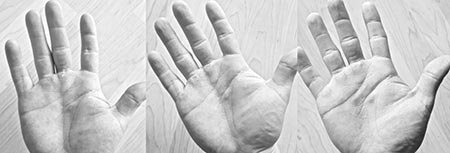
Basic Care
Minimize callouses
Your first and biggest strategy should be to stay on top of your callouses. When callouses get thick and dry is when you can run into problems with rips and tears. Once a callous rips, the skin underneath can be very tender, and depending on the depth of the tear can take over a week to heal. However, filing or shaving callouses down can help keep them in check, leading to less of a risk of having to take time off of training to let your hands recover. This is especially important if you are training for an event such as your SFG weekend.
My favorite preventative measure is to use a pumice stone at the end of a shower or after a contrast bath (more on this below). When the skin on your hands is soft from the water, it makes it easier to work the thickness down and keep them from reaching the point of ripping. Another option is to use a blade or a callous razor to cut the callous off. For obvious reasons, care must be used when cutting skin from your hands. The draw back with this method is, to cut the callouses off, they have to be fairly thick. The thicker the callous, the more chance of a rip. Staying on top of them with a pumice stone or rasp can help them not get to a risky stage.
Contrast bath
One great trick to help with recovery, that also feels great, is a contrast bath. The contrast bath is a way of flushing blood to and from an area in an attempt to assist in recovery of that area. You simply place your hands in hot water to encourage blood flow to the fatigued muscles followed by moving your hands to cold water to shunt the blood way. A basic protocol to follow is to spend 2 minutes in as hot of water as you can stand, without burning yourself followed by 1 minute in ice water alternating between the two 5-10 times. If you have a double sink at home, this is perfect but buckets, pails, or large Tupperware containers work as well.
Stretching/symmetrical training
Again, like other muscles in the body, the muscles in your hands can respond well to stretching. Stretching your fingers, hands, wrists, and forearms can all blend together a little. But it could be as simple as opening your hands as wide as possible followed by clenching your fists for a few reps throughout the day. You might also spend some time moving your wrists and fingers through a full range of motion. Work your wrists in circles in both directions, followed by each individual finger in big circles in each direction one at a time. 10 circles in each direction is a good volume to begin with. Finger circles can be a very strange feeling at first and can be quite challenging as well. Have patience with it and remember the objective is to help the hands recover and not to fatigue them further.
Forearms stretches can feel great as well, and Pavel’s book Super Joints is a very good option. It could be as simple as going on your hands and knees and walking your hands to the outside and back until your fingers are pointing at your knees. From here, shift your weight to the rear while keeping the heels of your hands on the floor.

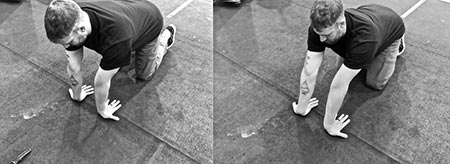
The last approach is to focus some attention on symmetry. With the amount of fingers and hands flexion that happens with training, it can be helpful to spend some time on fingers and hands extension. Wrapping a thick elastic band around your fingers and extending them against the resistance of the band can be a good way to work the fingers extensors. This can feel great, and can also have some positive impact on elbow discomfort you might be experiencing.
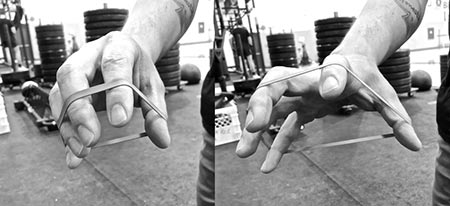
Moisturize
Once you have filed down your callouses and they feel soft and smooth, follow them up with a good moisturizing hand cream. Keeping the skin on your hands and more importantly, your palms and the base of your fingers soft and from drying out, is key to minimizing your chance of having to take any layoffs to recover injured or damaged hands.
The frequency with which you attend to your hands and the duration of time you spend on them is dictated by need. If you have increased your volume of swings, snatches, or clean or if you haven’t given your hands much attention and allowed callouses to get thick, you will generally require a little more time. As is suggested with soft tissue and mobility work, the same applies to hand care, frequency trumps duration. It’s better to spend 2-3 minutes 2-3 times per week as needed than it is to spend 10 minutes going to town on possibly already sore hands.
The Week before Your SFG Weekend
Just like any other component of your prep plan, the week before should be a taper week for your hands as well. A time to recover from your peaking cycle, allow any nagging injuries to heal and for you to be able to go into the weekend feeling fresh and ready to go. This is the time to get your hands to prime condition. Take care of any little issues that you might have. Knock your callouses down to the bare minimum and allow your hands to recover. This might even mean you will want to seek out a professional touch. Go and have a manicure or a hand massage. The fresher your hands can be going into the weekend the better.
The more time you spend figuring out your preferred hand care method the easier it will be for you to take care of your hands over the weekend.
The Weekend
Well, the event has finally arrived. You’ve done countless swings, many get-ups and are comfortable with all of the skills and are ready to learn. However, the volume of the SFG weekend is extremely high. In fact, that is one of the reasons I believe so strongly in StrongFirst. In order to join the ranks, you must walk the walk. If you have prepared correctly you will be ready. And looking after your hands will be extremely important as you move through the weekend. Here are some steps that can be of great help. Follow these each evening once you have been dismissed.
- Stretch your hands and fingers. Perform any hand/wrist/forearm stretch that you like. You may also want to wrap a thick elastic band around your fingers and extend them. You will have done so much flexing of your fingers and hands that this can feel really nice and help with blood flow. You will want to do this throughout the weekend and during breaks.
- Contrast baths. If you are like the majority of people who attend a StrongFirst event, you are staying in a hotel. Take your ice bucket and fill it up at least half way with ice, then fill it the rest of the way with water. Next, fill the sink in the bathroom with the hottest water you can stand without burning yourself. From here, alternate your hands between the hot water and cold water. Aim for 2 minutes hot and 1 minute cold. You might have to do one hand at a time and that is ok. This will help flush blood to and from the hands and really help with recovery.
- Pumice your callouses. After you’re finished in the contrast bath your hands will be soft and supple. The perfect condition for filing down any rough spots.
- Moisturize. Once you’ve finished the above steps, put moisturizing cream on your hands and get into your SFG manual.
The above steps are nothing crazy but can have a huge impact on your training as well as making your SFG weekend that much more enjoyable.
The StrongFirst Girya Certification weekend is such an amazing time to learn, meet new people, and to earn your title as a StrongFirst Instructor, it seems only prudent to do what is needed to get the most out of it. Putting some time into the part of your body that will be in contact with the kettlebell 100% of the time you are using it only makes good sense.

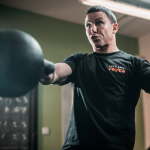
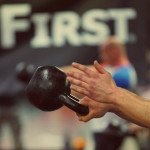
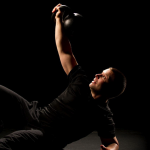


I like to use 220 grit for callouses on my hands and feet. And finger extension exercises in convict conditioning 2.
Fantastic article, thank you, Matt.
I am forwarding this to my SFG I students!
I found that those new battery-powered foot callus removers that you can get in any supermarket, are an outstanding tool for polishing down the calluses on the hands too.
Coconut oil is great for moisturizing the hands afterward, and when traveling to the cert it doubles as a healthy dose of medium chain fats to add to breakfast and coffee – tons of energy for the weekend.
Especially loved the reminder to use the elastic band. It does indeed prevent or ease elbow discomfort form all the gripping.
Thank you again!
Kat
Thank you very much Kat,
I’m glad you found it useful.
And thank you for the suggestion of coconut oil, that’s a great idea.
One other excellent callus care tool I have found is uric acid cream. I found one that is 40% /urea/uric acid called Urix40. Bought it online. I rub a tiny bit of that in to callus area about once or twice a week before bed. It softens the whole mass and makes it easier to remove top layers without ripping it from main part of skin